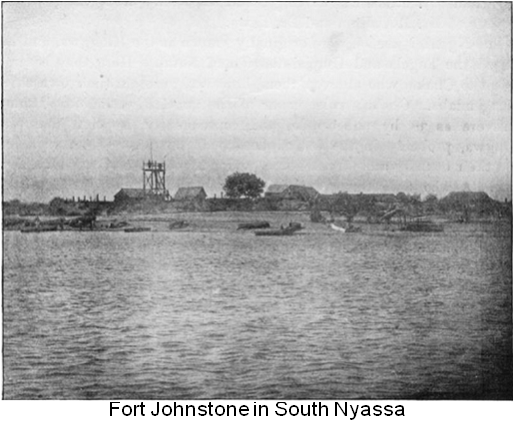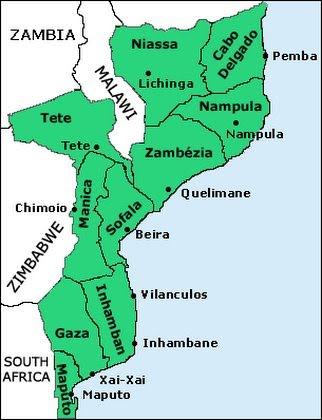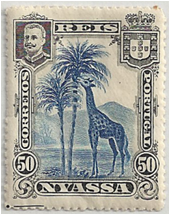ALBUM – View my Nyassa Company album
TRANSITION CHART – Mozambique Area
Fast Facts
Region: Southern Africa
Group: Mozambique Area
Classification: Colony, Portuguese
Prior Regime: Portuguese Mozambique Colony
Key Dates:
1498, Mar 1 – Vasco da Gama lands on Mozambique Island and “claims” the region of Portugal
1752 – Colony of Moçambique, Zambesi and Sofala separated from Portuguese India in Goa
1891 – Charter for Nyassa Company established
1910, Oct 4 – Portugal’s monarchy was overthrown, and a republican government was put in place
1929, Oct 27 – Nyassa Company charter not renewed and territory returned to Mozambique Colony
Following Regime: Portuguese Mozambique Colony
Scott Catalogue: (Nyassa) #1-125, J1-J9, P1, RA1-RA3, RAJ1-RAJ3
Pick Catalogue: none
Currency: 1000 reis = 1 mil reis, beginning 1912 100 centavos = 1 escudo
History

Until 1752, Portugal’s possessions on East Africa’s coast were administered by Portuguese India in Goa, but this changed when the region was placed under a Captain General who resided in the City of Mozambique. The Portuguese began to trade slaves (mainly destined to the French Mascarene islands, Mauritius and Reunion). With the loss of Brazil in 1822, and the slave trade being outlawed, Portugal began focusing more on its African possessions. Although the slavery was outlawed in Europe, the Portuguese continued a very lucrative slave trade with the Arabs and Ottomans until 1877.
During the Scramble for Africa in the 1880s, Portugal had to cede much of the territory it claimed in East Africa to Cecil Rhodes’ British South Africa Company and British East Africa Company, however Portugal’s claim over Mozambique was affirmed by the Berlin Conference of 1885. At this time, Mozambique’s infrastructure was developed with much assistance from the British, as both British Central Africa/Nyassaland and Northern Rhodesia both depended on railroads and roads connecting these areas with the ports of Beira and Mozambique.
 In 1891 the Portuguese shifted the administration of much of the country to large private companies which were granted control over mining, fishing, infrastructure, communications and taxing locals. In return the company was exempt from paying taxes for 25 years in exchange for 10% share ownership and 7.5% of the profits. The largest charters were given in 1891 to the Mozambique Company to administer the southern part of the country from Beira for 50 years and the British owned Nyassa Company for 35 years to control the territory north of the Lurio River. In 1892, the Zambezia Company was also established to administer the middle area of the country around the mouth of the Zambezi River. While the Zambezia Company was never officially chartered, it became the largest of the three.
In 1891 the Portuguese shifted the administration of much of the country to large private companies which were granted control over mining, fishing, infrastructure, communications and taxing locals. In return the company was exempt from paying taxes for 25 years in exchange for 10% share ownership and 7.5% of the profits. The largest charters were given in 1891 to the Mozambique Company to administer the southern part of the country from Beira for 50 years and the British owned Nyassa Company for 35 years to control the territory north of the Lurio River. In 1892, the Zambezia Company was also established to administer the middle area of the country around the mouth of the Zambezi River. While the Zambezia Company was never officially chartered, it became the largest of the three.
The Nyassa Company was granted a charter by the Portuguese government in 1891 to establish economic development and maintain Portuguese control in Nyassa (Niassa) Province and Cabo Delgado. It was founded by Bernard Daupais, a merchant from Lisbon; however the Nyassa Company was primarily owned by British and French interests.
The Nyassa Company managed the charter based on the “chibalo system”, a labor policy which forced the Mozambicans to work on plantations, cotton fields and on public works projects. Mozambicans were required to pay hut taxes that essentially kept the Mozambicans in debt. This forced labor assured that locals would work for Company owned plantations and activities, preventing them to growing their own crops for sale.
On 1 Feb 1908, King Carlos was assassinated in Lisbon. His oldest son, Luis Felipe, died as well, leaving his youngest son Manuel to take over the throne at the age of 19. His reign was short-lived, however, as revolution broke out in Portugal on 4 October 1910, and Manuel fled to exile in England, ending royal rule in Portugal. The Portuguese Republican Party ultimately deposed the constitutional monarchy and established a republican regime in Portugal. This can be seen in the stamps issued in the Province, as they were overprinted “REPUBLICA” beginning in 1911.
Overall, the Nyassa Company was not very effective, and when the charter expired, the Portuguese colonial government did not renew the contract. Territory was returned to Mozambique Colony 27 Oct 1929.
Stamps
 ALBUM
ALBUM
During this time period, the colony of Mozambique was not yet centralized and communication between the various Portuguese outposts was difficult. Therefore, the individual provinces of Mozambique: Inhambane (1895-1914), Lourenço Marques (1895-1920), the city of Quelimane (1913-1922), Tete (1913-1914), and Zambezia (1894-1917) issued their own stamps, as did the Mozambique Company (1891-1942) and the Nyassa Company (1897-1929).
In my opinion, Nyassa Company stamps are among the most attractive classical stamps that were issued. The initial stamps issued for the Nyassa Company in 1898 were stamps of Mozambique Colony and Zambezia, overprinted “NYASSA”.
In 1901, the Nyassa Company issued its own stamps. The 13 denominations featured two different pictorials, one Giraffe eating from a palm tree, and the second featured a mother and baby camel. Both designs featured the face of King Carlos in the upper left corner, and the coat of arms in the upper right. As postal rates changed in 1903 and 1910, these issues were surcharged and/or overprinted “PROVISORIO” to reflect the new values.
In 1911, with the establishment of the new republican government in Portugal, Nyassa Company issued a new series of definitive stamps. The new issues incorporated the giraffe and camel depictions of the previous issues and added a zebra design and the design of a caravel. Each of these stamp was overprinted “REPUBLICA” in red and interestingly included the face of King Manuel II in place of Carlos. The stamps were printed on various colors.
It is interesting that the new currency had been introduced on 22 May 1911, but for some reason Nyassa’s stamps weren’t updated until 1918, when the company overprinted original stamps of 1901 (featuring the face of King Carlos) with ”REPUBLICA” and surcharged them with the new currency.
There were two issues in 1921, the first were the King Manuel stamps overprinted ”REPUBLICA” and second was the introduction of a new overall design. These stamps now use the word ”COMPANHIA DO NYASSA” for the previously used ”NYASSA”. Also the country name of ”Portugal” no longer appears on the stamps. Using the same pictures of the giraffe, the caravel and the zebra from previous issues, these issues included the new pictures of a portrait of Vasco da Gama, and a small Arabian style sailing ship.
In addition to the beautiful definitive stamps, Nyassa Company a Newspaper stamp in 1898, triangle shaped postage due stamps in 1924, and Postal Tax stamps in 1925.
For more information on Nyassa Stamps, an excellent resource can be found at Nyassastamps.co.uk
Banknotes
Portuguese currency was used in Nyassa Company
Links
History of Mozambique – Hubert de Vries heraldry
The British Ultimatium of 1890
Nyassastamps.co.uk – wonderful resource




